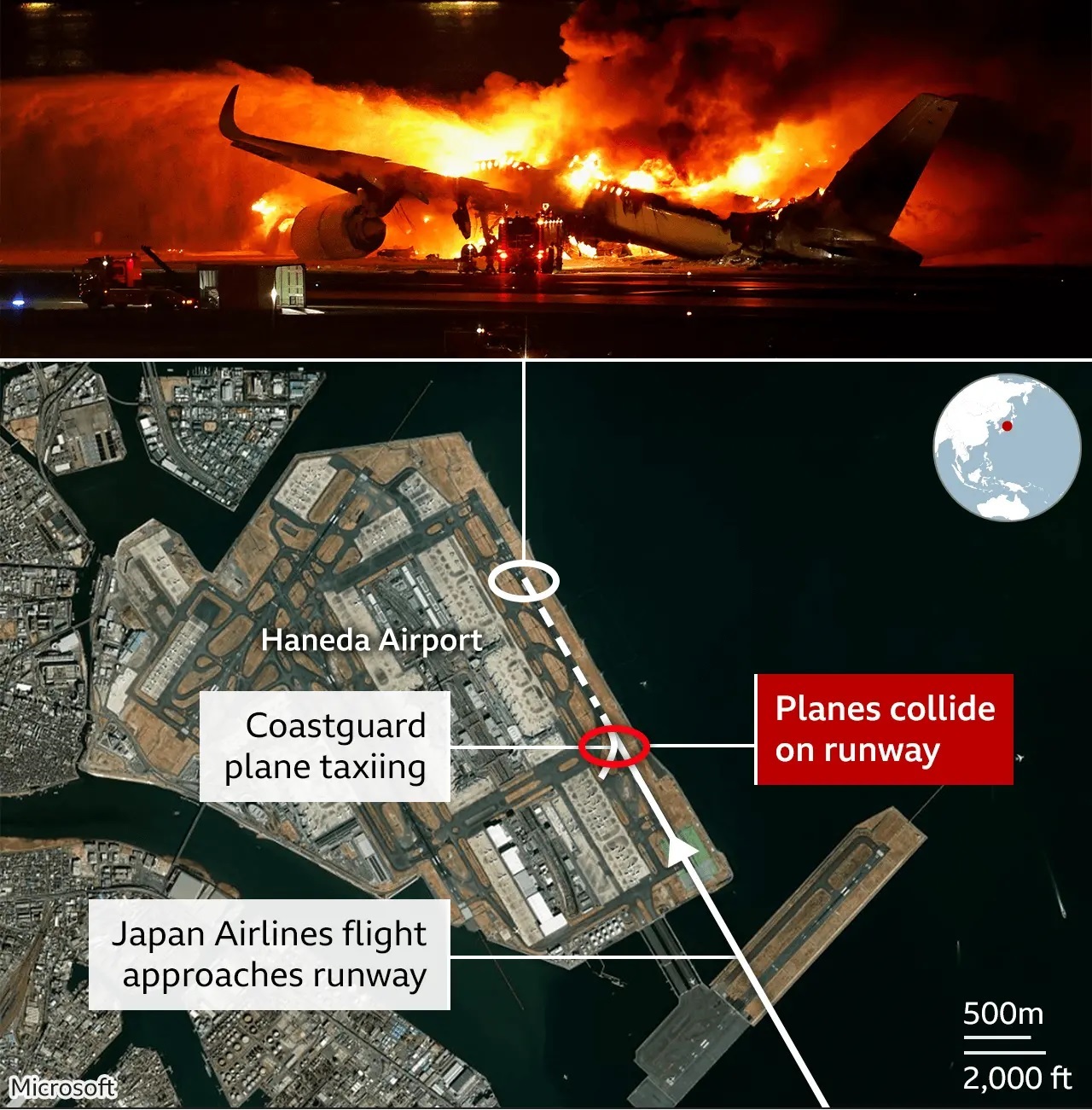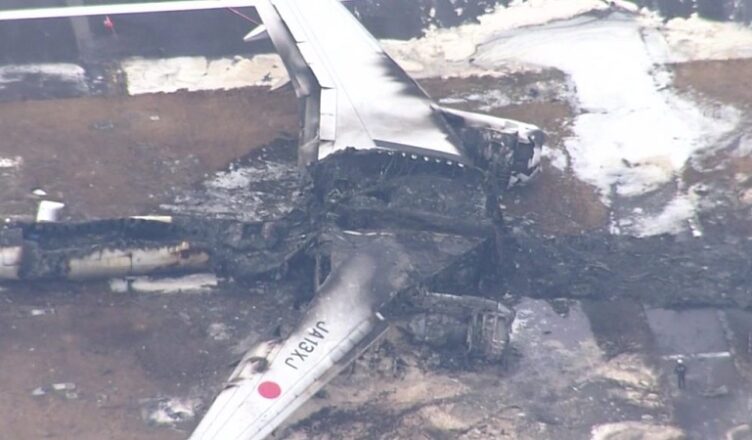Passengers dashed to the emergency exits of a burning Japan Airlines jet without their hand luggage, in compliance with the flight crew’s instructions.
The simple act of leaving their valuables behind would be a “major factor” behind the speed of the evacuation, with the last person escaping just before the aircraft was engulfed in flames on the runway of Tokyo’s Haneda Airport on Tuesday, aviation experts say.
Japan Airlines Flight 516 turned into a fireball after it collided with a coastguard plane as it landed. Five of the six people on board the smaller aircraft – which had been due to deliver aid to victims of the powerful New Year’s Day earthquake – died.
But everyone on Flight 516 survived, with the flawless evacuation from the cabin as it filled with smoke astounding the world and winning praise from many. Aviation experts and industry professionals told the BBC it boiled down to staff on board putting their rigorous training into practice and “well-behaved” passengers who obeyed safety protocols.
“I don’t see a single passenger on the ground, in any of the videos I’ve seen, that has got their luggage with them… If people tried to take their cabin luggage, that’s really dangerous because they would slow down the evacuation,” said Prof Ed Galea, director of the fire safety engineering group at the University of Greenwich in London.
To see what happens when passengers try to take their luggage with them, one only has to look back to a crash landing in Dubai in 2016. Footage from inside the Emirates Boeing 777 involved shows people panicking as they clamber to grab their possessions, before they fled down emergency slides.
The crew were praised for their efforts to evacuate passengers, and luckily all 300 on board the Dubai flight survived – but the video from inside that aircraft contrasts starkly with the well-drilled scenes witnessed in Tokyo on Tuesday.
Safety training kicked in
A former Japan Airlines flight attendant told the BBC that passengers on Tuesday’s flight – which had departed from Sapporo’s New Chitose airport at 16:00 local time (07:00 GMT) and landed at Haneda shortly before 18:00 – were “incredibly fortunate”.
In the end, just one passenger on board flight 516 sustained bruises and 13 others requested medical consultations due to physical discomfort, the airline said.
“I felt relieved to find out that all the passengers were safe,” the former flight attendant said. “But when I started thinking about the emergency evacuation procedure, I suddenly felt nervous and fearful.
“Depending on how the two planes collided and how the fire spread, it could have been a lot worse.”
According to the former attendant, all new crew members undergo stringent evacuation and rescue training for up to three weeks before they are allowed to serve in commercial flights. The training – which extends to how you control the tone and volume of your voice so you can be best heard by passengers – is repeated every year.
“We go through a written exam, case study discussions and practical training using different scenarios, such as when the plane has to make a water landing or if there is fire on board. Maintenance staff are also involved in such training,” said the former flight attendant, who left the airline 10 years ago.
On top of this, all aircraft manufacturers must show that everyone aboard can leave the plane within 90 seconds for their planes to be internationally recognised.
But even so, in real-life situations, it can be difficult to ensure that passengers do not panic, said the former flight attendant, who spoke on the condition of anonymity.
“What they achieved is harder than one can imagine. The fact that they managed to get everyone to escape is a result of good co-ordination among crew and passengers following instructions,” she said.
A pilot for a South East Asian airline, who also spoke on the condition of anonymity, agreed that the flight crew’s rigorous training was key to the passengers’ escape.
“I must say it was amazing,” he told the BBC. “You really don’t have time to think in a situation like this, so you just do what you were trained to do.”
It is all the more impressive when you take into account the position and condition of the aircraft, which – according to Prof Galea – would have made the evacuation all the more tricky.
“This accident was far from ideal. The aircraft was nose down, which meant it was difficult for passengers to move,” he said.
Only three inflatable slides could be used to evacuate passengers, but they were not properly deployed because of how the jet landed. The slide was very steep, which could have been dangerous.
The aircraft’s announcement system also malfunctioned during the evacuation, so the flight crew had to convey instructions using a megaphone and by shouting, Japan Airlines said.
But there were also signs the aircraft’s design was working to give those on board the best chance of escape. Prof Graham Braithwaite, director of transport systems at Cranfield University in the UK, told the BBC it looked like it “has done what it is designed to do, which is protect the occupants and allow a fast evacuation”.

Read full originally published story on bbc.com
